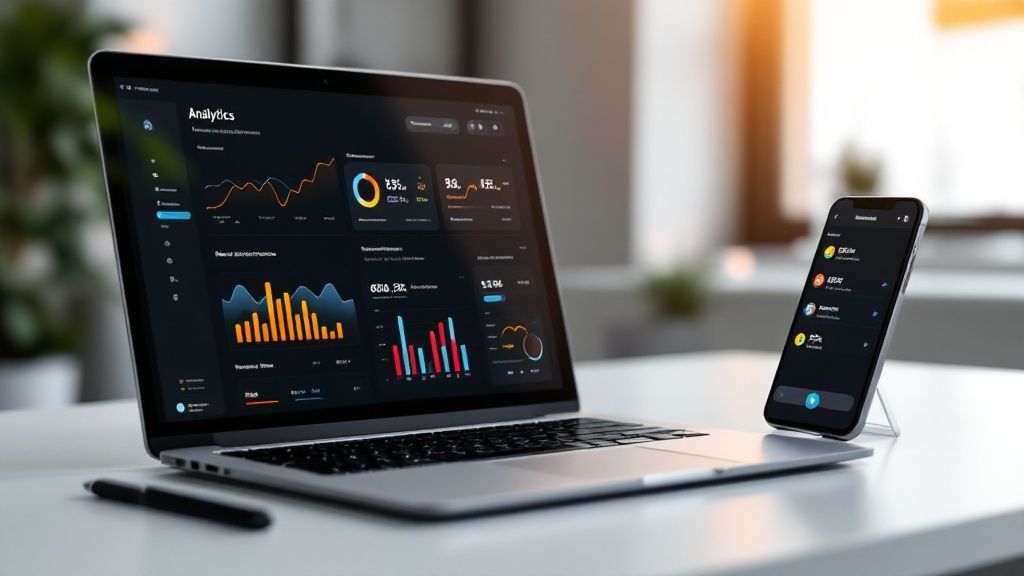Chasing likes and clicks can feel productive, but they don't tell the whole story. These are often vanity metrics, offering a surface-level view of your audience's interaction.
True customer engagement separates a one-time visitor from a loyal advocate who actively chooses your brand, time and time again. It’s a measure of the depth and quality of that relationship, built on meaningful interactions that directly impact retention and growth. Focusing on what truly matters requires shifting from passive consumption to active participation.

Defining Meaningful Interactions
So, how do you spot the signals of a genuine connection? It begins with analyzing a blend of indicators that reveal a customer's true intent and loyalty. Instead of just counting views, you must analyze the actions that follow.
Meaningful interactions generally fall into three key categories:
- Behavioral Signals: How are people using your product or service? Are they leveraging key features, spending significant time on your platform, or contributing to your community? These actions demonstrate they are receiving tangible value.
- Emotional Indicators: What is the sentiment behind their interactions? Metrics like Net Promoter Score (NPS) and Customer Satisfaction (CSAT) provide a window into their feelings and overall loyalty.
- Transactional Data: Are customers returning to make repeat purchases? The frequency and value of their transactions are powerful, undeniable signs of sustained engagement.
The goal is to move from tracking passive consumption to measuring active participation. An engaged customer doesn't just see your content; they interact with it, share it, and come back for more.
The Business Impact of True Engagement
This strategic focus on deeper metrics isn't just an academic exercise—it has a significant financial upside. The market for customer engagement solutions was valued at USD 23.45 billion in 2023 and is projected to more than double by 2030. This growth underscores that genuine engagement is now viewed as a critical business driver.
Ultimately, understanding how to measure customer engagement is the first step toward improving it. It allows you to build stronger relationships, reduce churn, and create a base of loyal advocates who will champion your brand. This foundational knowledge is closely tied to the broader concept of customer experience measurement, offering a holistic view of the entire customer journey.
Choosing Engagement Metrics That Drive Growth
Ever feel like you're drowning in data? The sheer volume of information can be paralyzing. The key is to select a handful of metrics that directly align with your business goals.
The right metrics for a SaaS platform differ completely from those for an e-commerce store. A one-size-fits-all approach is ineffective. To gain a clear picture, you need a balanced scorecard that combines behavioral, emotional, and transactional data. This provides a full, 360-degree view of how customers interact with—and feel about—your brand.
This flow chart breaks down the process, from defining your metrics to analyzing your findings.

As you can see, it’s a cycle: determine what to track, implement the right tools, and then use those insights to refine your strategy.
Identifying Key Behavioral Metrics
Behavioral metrics reveal what your customers are doing. They are the clearest indicators that people are deriving real value from your product. Instead of getting bogged down in surface-level activity, focus on actions that demonstrate a customer is truly invested.
Here are a few metrics that pack a punch:
- Feature Adoption Rate: For a SaaS business, this indicates which features are most popular. A low adoption rate for a new feature might signal confusing onboarding or that customers don't yet see its value.
- Pages Per Session: A high number here is a positive sign, suggesting visitors are engaged with your website content and exploring it easily. It's a strong signal that your content strategy is effective.
- Average Session Duration: A classic metric for a reason. It shows how long people are staying on your site or app. Longer sessions almost always correlate with higher engagement and deeper interest in your offerings.
Gauging Emotional and Transactional Signals
While behavioral metrics show actions, emotional and transactional metrics get to the heart of loyalty and satisfaction. These are vital for understanding the true health of your customer relationships.
Emotional signals like Net Promoter Score (NPS) and Customer Satisfaction (CSAT) offer a direct window into how your customers feel. They answer the crucial question: "Are our customers happy enough to recommend us?"
On the transactional side, metrics like Repeat Purchase Rate and Customer Lifetime Value (CLV) are the ultimate proof of genuine engagement. A customer who consistently returns to buy from you is, by definition, an engaged customer.
Experts often suggest tracking up to 20 distinct engagement metrics for a comprehensive view, covering everything from session length to CLV. The goal is to build a dashboard that provides clarity, not more confusion.
Key Engagement Metrics by Business Type
Not sure where to start? The right metrics depend heavily on your business model. This table breaks down which metric categories are most important for different business types, helping you prioritize what to track first.
Choosing from the right category ensures you're tracking actions that directly contribute to your bottom line. An e-commerce store obsessing over DAU/MAU might overlook the importance of repeat purchases, just as a media site focusing solely on AOV would be missing the point.
By selecting the right mix, you can ensure you’re tracking metrics that drive real, sustainable results. For a deeper dive into which KPIs to prioritize, check out our guide on essential digital marketing performance metrics.
Building Your Engagement Measurement Toolkit
The right tools can transform how you measure customer engagement from a tedious chore into a strategic advantage. You don't need a massive budget to get started; the key is to select platforms that provide clear, actionable insights into user behavior.
Building your tech stack begins with understanding what each tool does best. For instance, Google Analytics is the essential starting point for web behavior. It’s free and offers a wealth of data on session duration, pages per session, and traffic sources, answering the fundamental question: "What are people doing on my website?"
However, to dig deeper and gain a more granular view, you must move beyond basic page views and into event-based tracking.
Choosing the Right Platforms
This is where platforms like Mixpanel or Amplitude excel. Built specifically for product analytics, they track specific user actions, or "events"—such as a button click, a video play, or the use of a particular feature. This allows you to understand not just that users are on your site, but precisely how they are interacting with your product.
For a more holistic view that connects marketing, sales, and service interactions, a CRM like HubSpot is invaluable. It can track everything from email opens and CTA clicks to support ticket resolutions, giving you a complete timeline of a customer's journey with your brand.
Here’s a clear example from a Mixpanel dashboard showing how users engage with different features over time.

This type of visualization helps you quickly spot popular features and identify those that might need better user onboarding. It’s about seeing patterns at a glance.
Creating a Unified Customer View
The real strategic advantage comes from connecting these separate data sources. When your website analytics, product usage data, and CRM records exist in silos, you see only fragments of the customer story. The objective is to piece it all together into one unified view.
A unified customer view means that when you look at a customer's profile, you see their first website visit, every feature they've used, every purchase they've made, and every support ticket they've submitted—all in one place.
This is where data integration becomes critical. Pulling information from different systems into a centralized dashboard or data warehouse allows you to ask more sophisticated questions. For a deeper look, our guide on customer data integration solutions offers a practical framework for getting your tools to communicate effectively.
Ready to build this unified view? Focus on these practical first steps:
- Define Your Key Events: First, identify the top 5-10 user actions that signify "high engagement" for your business. This could be anything from "completing onboarding" and "using a core feature three times" to "making a second purchase."
- Implement Tracking: Next, use tools like Google Tag Manager or native capabilities within Mixpanel to set up tracking for these specific events across your website and application.
- Build a Simple Dashboard: Start with a basic dashboard in a tool like Google Data Studio or within your CRM. At a minimum, it should display your North Star Metric alongside the key behavioral, emotional, and transactional indicators you selected.
This foundational toolkit provides the framework needed to measure customer engagement accurately. As your business grows, you can layer in more specialized tools, but starting with this core stack ensures you have a scalable system for turning raw data into meaningful insights.
Using AI to Predict and Personalize Engagement
Traditional methods of measuring customer engagement often feel like driving while looking in the rearview mirror—analyzing past actions to understand what already happened. But what if you could look ahead? Artificial intelligence flips the script, enabling you to predict customer behavior and turn your data into a proactive engagement engine.
AI-powered tools go beyond simple metrics like open rates. They use machine learning to analyze vast amounts of data, uncovering subtle patterns in user behavior that are invisible to the human eye. This is fundamentally changing how we approach customer interaction.
This isn't a future trend; it's happening now. It’s projected that by 2025, AI will be involved in 95% of all customer interactions. This is why business leaders are investing heavily in AI tools like intelligent chatbots. This is the new standard.
From Reactive to Predictive Analytics
The primary advantage of AI here is its predictive power. Instead of waiting for a customer to become inactive or cancel their subscription, predictive analytics can flag at-risk accounts long before they churn.
Consider this: an AI model might identify a specific pattern. Customers who ignore new feature announcements, have shorter session times, and stop opening support emails are 85% more likely to churn in the next 30 days. Armed with that knowledge, you can launch a targeted re-engagement campaign for that specific group, perhaps offering a personalized tutorial or a special discount to bring them back.
This is how you measure engagement with an eye toward the future, not just the past.
By analyzing thousands of data points in real-time—from product usage to support ticket sentiment—AI can assign a dynamic "engagement score" to every user. This score becomes a powerful leading indicator of customer health, telling you precisely where to focus your retention efforts.
Hyper-Personalization at Scale
Personalization is another area where AI is a game-changer. It can analyze a customer's entire history with your brand to determine the perfect next step, whether that's recommending a product, suggesting a helpful article, or sending a promotional offer at the ideal moment.
Here’s what that looks like in practice:
- Smarter Content Recommendations: An AI observes a user frequently reading blog posts about data integration. It then automatically surfaces a relevant case study or webinar for them.
- Customized Onboarding: For a new software user, an AI might analyze their job title and initial actions to customize the onboarding flow, highlighting the features most valuable to them.
This kind of one-to-one experience was once impossible to deliver at scale. Now, it’s not only possible but expected. If you're looking to explore further, check out our list of the 12 best AI tools for digital marketing. By integrating these intelligent systems into your workflow, you’re no longer just tracking engagement—you’re actively shaping it.
Turning Your Engagement Data Into Action

Collecting engagement data is only half the battle. The real value emerges when you use those insights to make smarter decisions about your product, marketing, and overall customer experience. This is where you close the loop, turning measurement into tangible business results.
Data without action is just noise. The goal is to build a repeatable process for identifying problems, forming educated hypotheses, and testing solutions. This transforms customer engagement tracking from a passive reporting task into an active engine for growth.
Let's walk through a common real-world scenario to see this in practice.
Diagnosing a Drop in User Activity
Imagine you run a B2B SaaS platform. Your analytics dashboard shows that Daily Active Users (DAU) have dropped by 15% over the last month. This raw number is alarming, but it doesn't explain why it's happening. It’s time to investigate.
Your first step is to segment the data. Is this drop occurring across all users, or is it concentrated in a specific group? Perhaps it's new users who signed up in the last 60 days, or maybe it's affecting your tenured power users.
A deeper analysis reveals the decline is almost entirely from users in their second month. This insight immediately narrows your focus. The problem isn't your marketing funnel or the core value for long-term customers; something is going wrong after the initial onboarding phase.
Building a Data-Backed Hypothesis
Now you can form a hypothesis based on evidence. You suspect that once users complete the initial setup, they aren't discovering the advanced features that make your tool sticky. They experience the initial "aha!" moment but fail to integrate the product into their daily workflow.
Your hypothesis becomes: "If we proactively guide second-month users toward our advanced reporting features, their engagement will increase because they will unlock more value." This is a specific, testable idea—not a vague guess.
A strong hypothesis connects a specific action to a measurable outcome. It moves you from "I think users are confused" to "If we do X, we believe Y will happen, and we can measure it with Z."
Launching a Targeted Campaign
With a clear hypothesis, you can design a targeted re-engagement campaign instead of a generic "we miss you" email. Your action plan might involve several precise, coordinated steps:
- Segmented Email Nurturing: Set up an automated email sequence that triggers for users who have been active for 30 days. This sequence could showcase one advanced feature each week, complete with a short video tutorial.
- In-App Guided Tours: Use in-app pop-ups or tooltips that appear only for this user segment, pointing them to the powerful reporting dashboard they haven't used yet.
- Personalized Outreach: For high-value accounts in this group, have your customer success team reach out directly to offer a personalized 15-minute demo of those advanced features.
By tying these actions back to user behavior, you can see which touchpoints are making a difference. Understanding how different activities guide the customer journey is a key part of marketing attribution.
After running this campaign for a month, you can return to your data. Did DAU for this segment recover? Did you see a spike in the adoption of your reporting features? This continuous cycle of diagnosis, hypothesis, and action is what turns your engagement metrics into a powerful source of sustainable growth.
Got Questions About Measuring Engagement?
Even with the best tools and a solid strategy, questions are bound to arise when figuring out how to measure customer engagement. It's a complex area, and encountering a few challenges is part of the process. Let's address some of the most common questions.
Getting these fundamentals right will help you move past initial confusion and focus on what truly matters: using your data to build stronger customer relationships. Many businesses get stuck trying to find a single perfect metric, but the reality is more nuanced.
What's the Single Most Important Metric to Track?
There's no magic bullet. The "most important" metric is entirely dependent on your business model and what constitutes a valuable customer interaction. For a SaaS company, it might be Daily Active Users (DAU). For an e-commerce brand, it's likely the Repeat Purchase Rate.
Instead of searching for one metric to rule them all, identify a "North Star" metric. This is a single, powerful number that best captures the core value your customers get from your product. Focusing on a North Star provides incredible clarity and aligns your entire team toward a common goal.
How Often Should I Be Looking at These Metrics?
Your tracking rhythm should match the nature of the metric. You don't need to be glued to a real-time dashboard for everything—that's a surefire way to get overwhelmed. Setting a practical cadence helps you react effectively without getting sidetracked by minor fluctuations.
A balanced approach often looks like this:
- Quarterly: Big-picture, strategic metrics like Net Promoter Score (NPS) are ideal for a quarterly review. This allows enough time to see real shifts in long-term sentiment.
- Monthly: Transactional data, such as Churn Rate and Customer Lifetime Value (CLV), typically aligns well with monthly business reporting cycles.
- Weekly or Daily: More granular behavioral metrics, like user activity on a new feature or daily sign-ups, should be monitored more frequently to spot trends and address issues quickly.
Can I Measure Engagement if I'm on a Tight Budget?
Absolutely. While premium platforms offer advanced features, you can get started with powerful and free (or low-cost) options. The key is to begin collecting data consistently, even with a simple setup.
You don't need a massive budget to get started; you need a disciplined approach. The goal is to build a habit of measurement first, then expand your toolkit as your needs and budget grow.
Google Analytics is a robust tool for tracking web behavior, and it’s completely free. You can also use simple surveys with tools like Google Forms to gather invaluable feedback on customer satisfaction. Even a well-organized spreadsheet is a fantastic starting point for tracking your key numbers.
At Twelverays, we help businesses move beyond guesswork by implementing data-driven strategies that deliver real results. If you’re ready to turn your customer data into a powerful growth engine, learn more about our tailored CRM and digital marketing solutions at https://twelverays.agency.





